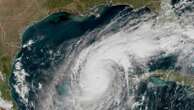Hurricane Helene is now one of the deadliest Atlantic hurricanes since 1950, killing at least 235 people as of Tuesday. An unknown number, likely hundreds, are still missing and more than 250,000 households from Florida to Virginia still don’t have power nearly two weeks after landfall. Recovery efforts could take months or even years in remote parts of southern Appalachia where the destruction from historic rains and flooding was nearly total.
As climate change continues to warm the oceans and increase the destructive potential of tropical cyclones, new types of threats are emerging. Helene’s heartbreaking devastation draws attention to the increasing risk that hurricanes pose far away from their initial point of landfall, and far beyond wind and waves close to the coast. In our globalized economy, disasters like Helene are beginning to stretch critical supply chains to their breaking point.
Case in point, during Helene, months worth of rain fell in just a few days across the mountains of the Carolinas and north Georgia. North Cove, N.C.-based Baxter International, the nation’s largest producer of IV fluids for medical use, said in a statement last week that a levee breach and multiple bridge failures made it impossible for them to continue operations. The company says it doesn’t have a timeline for when the shuttered plant will reopen, but NPR speculated that it could be weeks or even months, when compared to “similar situations in the past.”
Up to 80% of admitted hospital patients require an IV at some point during their stay, so the loss of some 60% of the nation’s IV fluid manufacturing capacity is sending ripple effects to healthcare providers across the country. Baxter says it has been working with the FDA and other federal agencies to allow it to temporarily import IV fluid from its global manufacturing network to help alleviate the supply crunch.
As the news of the shortage broke late last week, hospitals took immediate steps to conserve IV fluid.
In an email to staff, Children’s Minnesota said it would be allocated much less IV fluid than they are used to from their suppliers, “up to 40% of our past six-month utilization, which is significantly less than our historical usage during [flu] season.”
Rachel Weigert, a physician in the ER at Children’s Hospital in Minneapolis, told Fast Company that statement actually understates the severity of the situation at the moment.
“They told us we had about one week’s supply left, and we were limited to patients that actually need it for survival,” said Weigert. “In the past two shifts, I would have ordered fluids for about 10 kids that I saw, but I didn’t. I tell the parents, ‘we’re in a critical shortage of saline right now and thankfully your child doesn’t need it.’ I don’t know what the total amount remaining is. I don’t know if any of us know. ”
Actions like these are being taken in nearly every hospital in the country right now.
Massachusetts General instructed its doctors to offer oral hydration and Gatorade to its patients who are able to drink in lieu of IV fluids, and said that its quality of care would not be affected. The California Hospital Association told its members it would appeal to state officials for help in sourcing IV fluid, if necessary. A few hospitals, like Allina Health in Minnesota and the University of Toledo hospital in Ohio, have paused elective surgeries temporarily.
Incidents like this are beginning to happen with increasing regularity.
In 2017, Hurricane Maria’s landfall in Puerto Rico triggered a nationwide shortage of the plastic bags hospitals use to administer IVs, creating similar bottlenecks and restrictions. In 2022, severe flooding in Michigan worsened an ongoing infant formula shortage. And last year, when a tornado struck a North Carolina Pfizer facility that produced anesthesia, it kicked off a panic buying spree that risked exacerbating the drug shortage. To limit hoarding, Pfizer’s disaster response plan included limiting hospital orders to no more than 100% of their typical quantity, and its production lines were back up and running in weeks, not months.
Earlier this year, Kings College London published the first study to ever assess the likely impact of climate change on global supply chains. The results were staggering: $25 trillion over the next 35 years in a worst-case scenario where global greenhouse gas emissions aren’t curtailed. Another study found that among all countries, the United States was most at risk of supply disruptions.
The main ingredient of IV fluids, of course, is water. Large quantities of difficult-to-produce medical-grade water is required not just for IVs, but in the manufacture of thousands of different pharmaceutical products and medicines. The healthcare industry uses about 5% of U.S. purified water annually, worsening water shortages that are being triggered by climate change. In places with a high concentration of pharmaceutical manufacturing, like Puerto Rico, medical-related water usage rises to as high as 65% of the island’s total water supply. Puerto Rico in particular is expected to face increasing water shortages as climate change intensifies.
What’s worse, a recent report from the U.S. Department of Health and Human Services found that “drug and device manufacturers are disproportionately located in areas of high risk of natural hazards such as tornadoes, earthquakes, hurricanes, and other extreme weather events.” So not only is our healthcare system reliant on dwindling water resources, we’ve built critical components of that system in places where climate disasters are most likely to strike, like North Carolina and Puerto Rico.
Experts say an over-reliance on just-in-time deliveries also makes shortages more common, and not just in the medical industry. After Hurricane Maria and after Covid, medical suppliers have added redundancies at the urging and support of the Biden administration.
What’s needed is a total rethink of supply chains, designed for an era of increasing unpredictability. Instead of a just-in-time model, the Biden administration has urged the concept of systemic resilience as part of its Build Back Better plan, forming a White House Council on Supply Chain Resilience this summer.
In the emergency room of Children’s Hospital in Minneapolis, however, planning for the future doesn’t help the current shortage. Since Covid, doctors there have had to grow accustomed to “the ambiguity of not knowing”, in Weigert’s words, whether critical supplies like masks or IV fluid would be available that day. They’ve come up with creative solutions when necessary and are already brainstorming what they’ll do if the current IV fluid shortage grows more acute. Weigert speculates that in six weeks or so, if the current shortage persists, they may begin administering fluids directly into the stomach through the nose in critically ill patients, for example. She also hopes these chronic shortages will help shift how her hospital and the entire medical system plan for climate change. “There are times where necessity drives ingenuity,” she says.








No comments